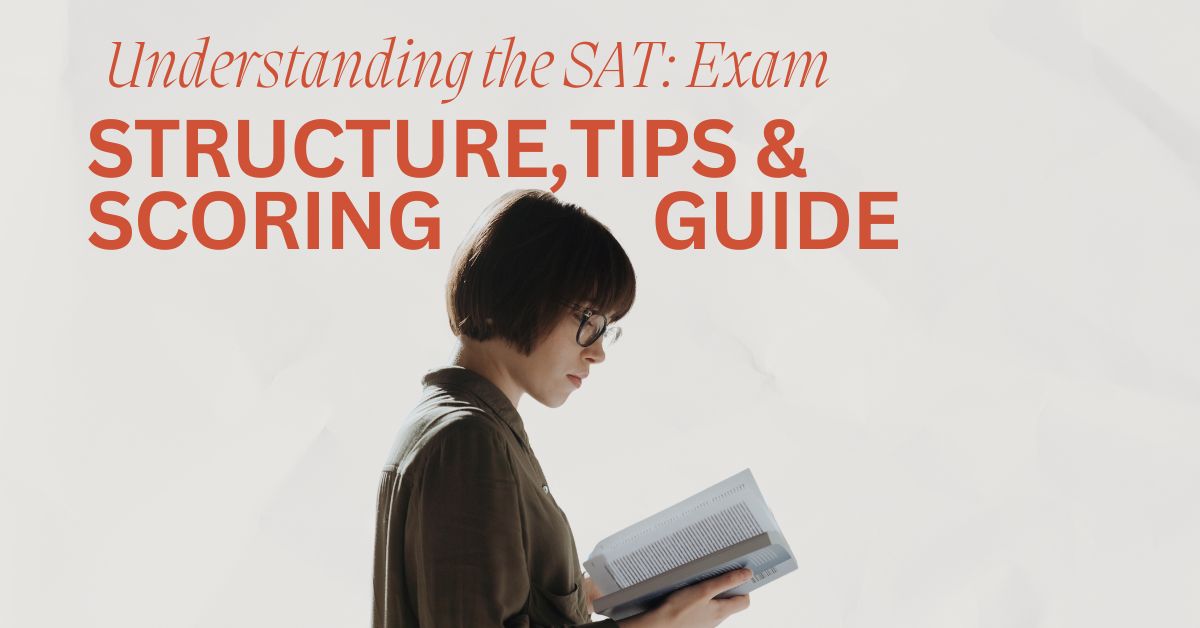The SAT is a standardized test widely used for college admissions in the United States, and preparing for it can significantly impact your chances of success. This article will break down the SAT exam structure, offer preparation tips, and discuss the scoring guide to help you achieve your best possible score. Additionally, we’ll explore the SAT exam syllabus and SAT exam subjects to give you a clear understanding of what you’ll encounter on test day.
1. Overview of the SAT Exam Structure
The SAT is divided into four main sections:
- Reading
- Writing and Language
- Math
- Optional Essay (in some versions, as per recent changes)
Each section tests specific skills and follows a particular format, and understanding this structure will help you approach the test more confidently.
- Reading Section: The SAT Reading section includes 52 questions and lasts 65 minutes. You’ll encounter a variety of passages from classic or contemporary literature, U.S. or world history, social studies, and sciences. This section measures your ability to comprehend texts, interpret words in context, and analyze evidence-based arguments.
- Writing and Language Section: This section has 44 questions, with a time limit of 35 minutes. Here, you’ll answer questions that assess your command of grammar, vocabulary in context, and ability to improve the organization of ideas within a passage. It’s crucial to understand punctuation, sentence structure, and word choice for this section.
- Math Section: This section consists of two parts—one where you can use a calculator and one where you cannot. There are a total of 58 questions, and the entire section lasts 80 minutes. The Math section covers essential areas from the SAT Exam Syllabus, such as algebra, problem-solving, data analysis, and some advanced math concepts. Mastery of basic formulas and problem-solving techniques is essential here.
- Essay (Optional): The optional SAT Essay section provides 50 minutes for you to analyze an argument presented in a passage. This task is often optional, depending on the college requirements, but it can demonstrate your critical thinking and writing skills effectively.
2. Deep Dive into the SAT Exam Syllabus and Subjects
Each section has a specific syllabus or set of subjects you should be familiar with before test day. Here’s a closer look at the topics covered in the SAT exam syllabus:
- Reading: Expect passages on literature, historical documents, social sciences, and science. It’s essential to develop strong reading comprehension skills, as questions will ask you to identify main ideas, interpret evidence, and understand relationships between different ideas within a passage.
- Writing and Language: This section requires knowledge of grammar rules, usage, punctuation, and understanding effective ways to improve sentence flow. Key areas include sentence structure, transitions, and vocabulary in context, with an emphasis on making passages clearer and more effective.
- Math: The SAT exam syllabus for math includes subjects such as algebra (equations, inequalities), problem-solving and data analysis (ratios, percentages), and advanced math topics (trigonometry, complex numbers). This section assesses your ability to apply mathematical concepts to real-world scenarios and think analytically.
- Essay (Optional): This section is generally structured around argumentative writing. It requires you to analyze a persuasive essay and discuss the author’s use of evidence, reasoning, and stylistic elements.
Understanding these subjects will help you focus your study sessions on the areas that matter most.
3. Tips for SAT Preparation
Once you understand the SAT exam structure and syllabus, effective preparation becomes the next critical step. Here are some practical tips to help you maximize your score:
- Familiarize Yourself with the SAT Format: Before diving into practice tests, get comfortable with the SAT format and time constraints of each section. Familiarity will reduce test-day stress and help you navigate each part more efficiently.
- Take Practice Tests: Taking full-length SAT practice tests is invaluable for building stamina and identifying areas where you may need improvement. Time yourself to simulate real test conditions, and review your answers to understand your mistakes. This practice will also help you master pacing, which is crucial for a timed exam like the SAT.
- Focus on Weak Areas: After taking a few practice tests, review your answers to identify patterns in mistakes. Use this information to target specific subjects or types of questions where you need improvement. For instance, if you struggle with algebra in the Math section, dedicate more time to reviewing that topic.
- Improve Your Reading Speed: The SAT Reading section is lengthy and can be challenging to complete within the given time. Practice reading complex texts regularly to improve your speed and comprehension. Additionally, try skimming techniques to identify main ideas faster, which can save time on test day.
- Brush Up on Grammar Rules: Since the Writing and Language section requires a solid grasp of grammar, it’s essential to review grammar rules, punctuation, and sentence structure. Resources like grammar guides and practice exercises can be helpful in this area.
- Memorize Formulas: While the SAT provides some formulas, knowing key formulas by heart (such as those related to geometry, algebra, and trigonometry) can save you time in the Math section. Practice applying these formulas in various contexts to become more comfortable with them.
4. Understanding the SAT Scoring Guide
The SAT uses a scaled scoring system, with each section contributing to a total score out of 1600 points:
- Evidence-Based Reading and Writing: Scored from 200 to 800.
- Math: Scored from 200 to 800.
- Essay (Optional): Scored separately on a scale of 2-8 for reading, analysis, and writing.
Your scores in the Reading and Writing sections are combined to give a total Evidence-Based Reading and Writing score, which, alongside your Math score, forms your overall SAT score. While there’s no penalty for wrong answers, strategic guessing can be helpful if you’re unsure about a question.
5. Final Thoughts
Preparing for the SAT may seem daunting, but breaking it down into sections and focusing on key areas within the SAT Exam Subjects can make it more manageable. Understanding the exam structure, becoming familiar with the SAT exam syllabus, and following effective preparation tips will give you a solid foundation for success. Remember, consistency and targeted practice are essential, so start early and focus on steady improvement. With these strategies, you’ll be well on your way to achieving the SAT score you’re aiming for.




